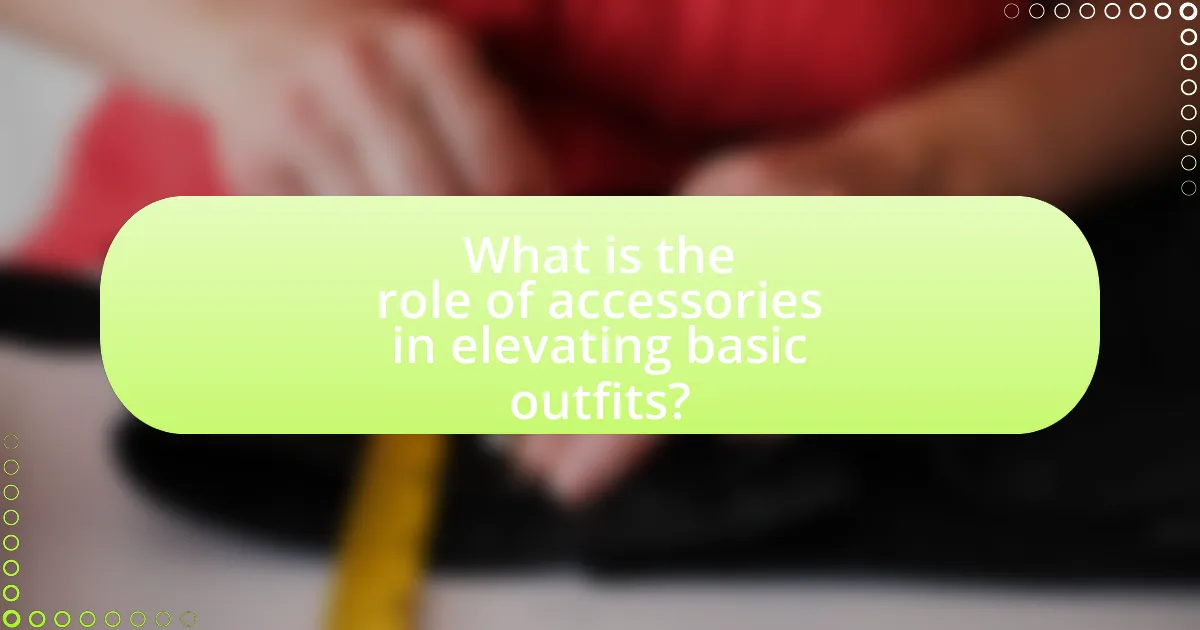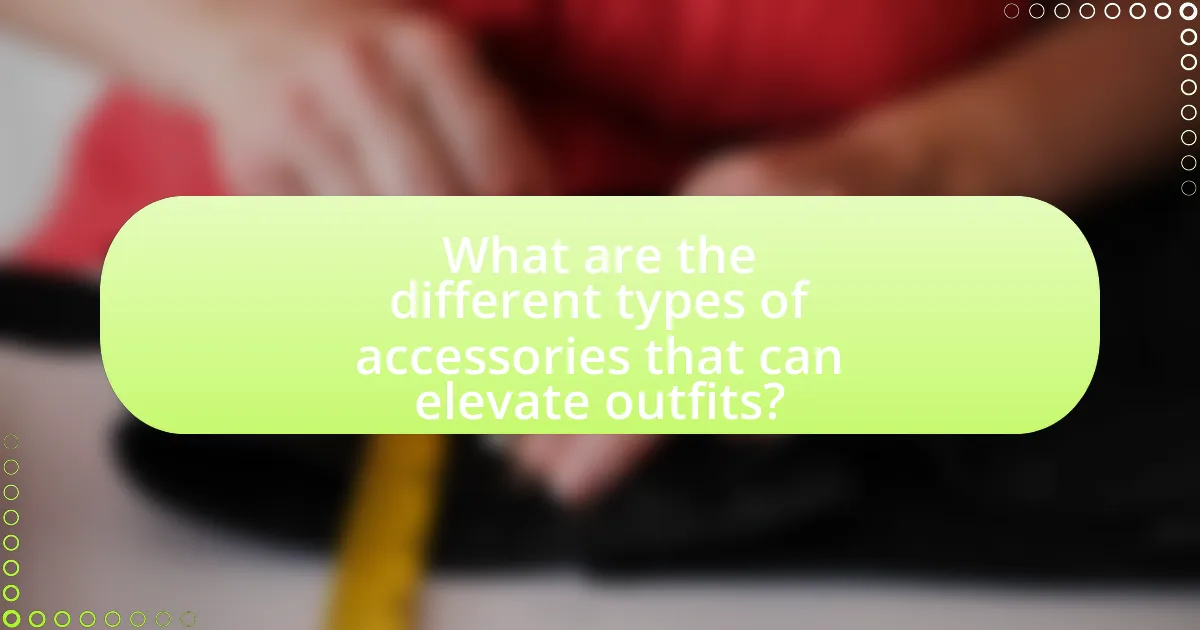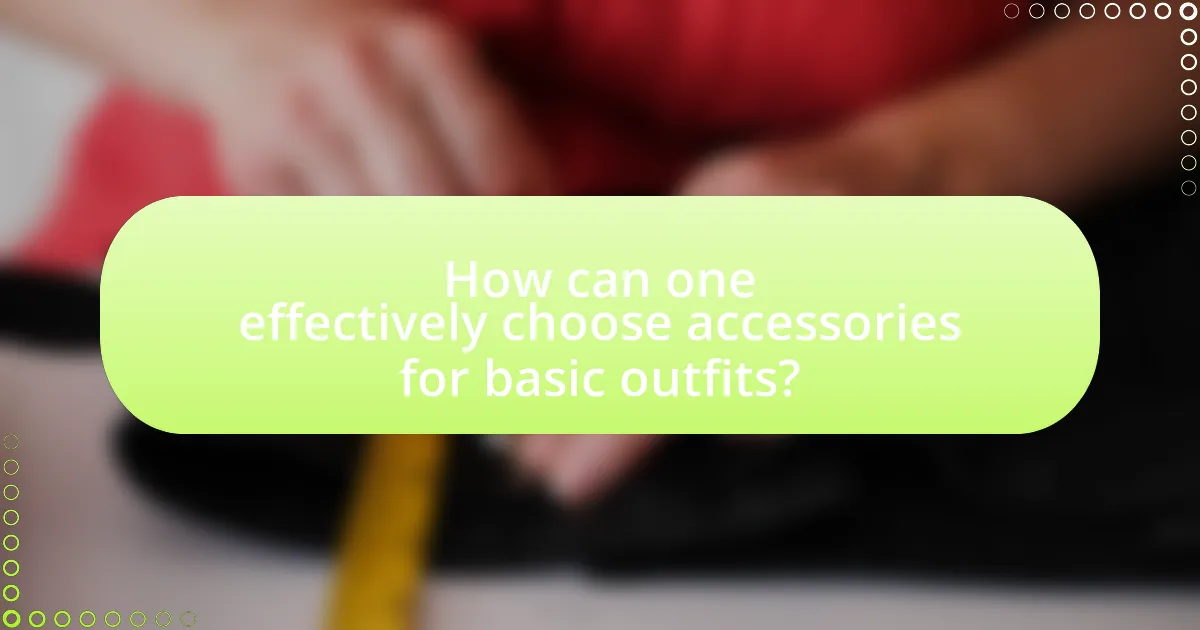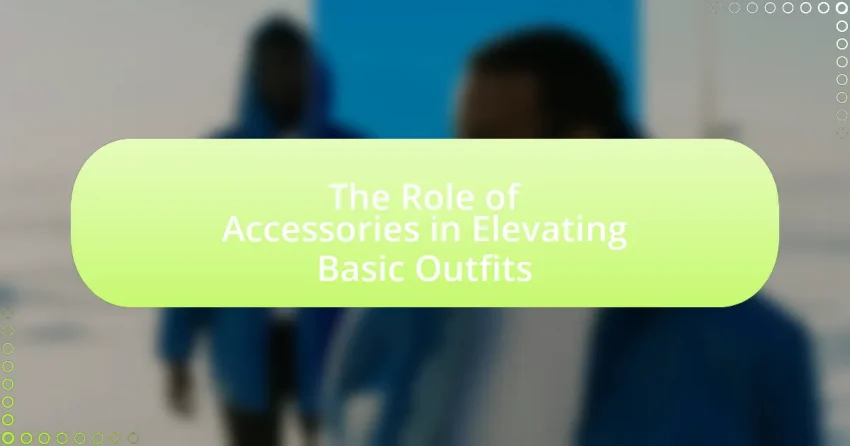The article focuses on the role of accessories in elevating basic outfits, emphasizing their importance in adding visual interest, personal style, and versatility. It discusses how accessories such as jewelry, bags, and shoes can transform simple clothing into fashionable ensembles, enhancing perceived attractiveness and confidence. Key types of accessories, their psychological effects, and the significance of color coordination and balance in accessorizing are explored. Additionally, practical tips for selecting and mixing accessories are provided, highlighting common mistakes to avoid for a polished appearance.

What is the role of accessories in elevating basic outfits?
Accessories play a crucial role in elevating basic outfits by adding visual interest and personal style. They transform simple clothing into more fashionable ensembles, allowing individuals to express their personality and creativity. For instance, a basic white t-shirt and jeans can be instantly upgraded with statement jewelry, a stylish handbag, or unique footwear, creating a more polished and intentional look. Studies in fashion psychology indicate that accessories can enhance perceived attractiveness and confidence, as they often serve as focal points that draw attention and convey individual style preferences.
How do accessories transform a basic outfit?
Accessories transform a basic outfit by adding visual interest, personal style, and versatility. For instance, a simple dress can be elevated with statement jewelry, a stylish belt, or a unique handbag, which enhances the overall aesthetic and reflects the wearer’s personality. Studies show that accessories can significantly influence perceptions of style; a survey by the Fashion Institute of Technology found that 70% of respondents believe accessories are crucial for completing an outfit. This demonstrates that accessories not only enhance the look but also play a vital role in how outfits are perceived.
What types of accessories are most effective for this transformation?
Statement necklaces, oversized sunglasses, and structured handbags are the most effective accessories for transforming basic outfits. Statement necklaces add a focal point and elevate simplicity, while oversized sunglasses provide a chic, glamorous touch. Structured handbags enhance the overall silhouette and convey sophistication. These accessories have been shown to significantly enhance visual appeal and style, making them essential for elevating basic outfits.
How do different accessories impact the overall look?
Different accessories significantly enhance the overall look by adding style, personality, and cohesion to an outfit. Accessories such as jewelry, belts, bags, and hats can transform a basic outfit into a statement ensemble, influencing the perception of the wearer’s fashion sense. For instance, a simple dress can appear more sophisticated with the addition of a statement necklace or a stylish handbag, while a casual outfit can be elevated with a well-chosen belt or trendy shoes. Studies in fashion psychology indicate that accessories can affect how individuals are perceived, with research showing that well-coordinated accessories can enhance attractiveness and confidence (source: “The Psychology of Fashion” by Carolyn Mair).
Why are accessories important in fashion?
Accessories are important in fashion because they enhance and personalize outfits, allowing individuals to express their unique style. By incorporating items such as jewelry, bags, belts, and hats, one can transform a basic outfit into a statement look. Studies show that accessories can significantly influence perceptions of style; for instance, a survey by the Fashion Institute of Technology found that 70% of respondents believe accessories are essential for completing an outfit. This demonstrates that accessories not only add visual interest but also play a crucial role in defining personal identity and fashion sense.
What psychological effects do accessories have on personal style?
Accessories significantly influence personal style by enhancing self-expression and boosting confidence. The incorporation of accessories allows individuals to convey their personality, mood, and social status, which can lead to a positive self-image. Research indicates that wearing accessories can trigger psychological effects such as increased feelings of attractiveness and social acceptance. For example, a study published in the Journal of Experimental Social Psychology found that individuals who accessorized reported higher levels of self-esteem and perceived social value. This demonstrates that accessories not only serve a functional purpose but also play a crucial role in shaping one’s psychological perception of self and others.
How do accessories reflect individual personality and taste?
Accessories reflect individual personality and taste by serving as personal expressions that convey style preferences and values. For instance, a person who chooses bold, colorful jewelry may indicate a vibrant and outgoing personality, while someone who opts for minimalist designs might reflect a preference for simplicity and elegance. Studies show that accessories can significantly influence first impressions; research published in the Journal of Experimental Social Psychology found that individuals often make judgments about others’ personalities based on their accessory choices. Thus, the selection of accessories not only enhances an outfit but also communicates deeper aspects of one’s identity and aesthetic sensibilities.

What are the different types of accessories that can elevate outfits?
Different types of accessories that can elevate outfits include jewelry, belts, bags, hats, scarves, and shoes. Jewelry, such as statement necklaces or earrings, adds visual interest and can transform a simple outfit into a stylish one. Belts can define the waist and add structure, while bags serve both functional and aesthetic purposes, enhancing the overall look. Hats can provide a fashionable flair and protection from the elements, and scarves can add color and texture. Shoes, particularly unique or bold styles, can significantly impact the outfit’s overall vibe. Each accessory type plays a crucial role in enhancing and personalizing outfits, making them more visually appealing and expressive.
How do jewelry pieces enhance basic outfits?
Jewelry pieces enhance basic outfits by adding visual interest and personal expression. Accessories like necklaces, earrings, and bracelets can transform a simple ensemble into a stylish statement, drawing attention and creating focal points. For instance, a basic white t-shirt and jeans can be elevated with a bold statement necklace, which not only adds color but also showcases individual style. Studies indicate that accessories can significantly influence perceptions of attractiveness and fashion sense, reinforcing the idea that jewelry plays a crucial role in outfit enhancement.
What types of jewelry are best for casual versus formal looks?
Casual looks benefit from simple and understated jewelry, such as stud earrings, delicate necklaces, and minimalist bracelets. These types of jewelry complement everyday outfits without overwhelming them. In contrast, formal looks are enhanced by statement pieces like chandelier earrings, bold necklaces, and intricate bracelets, which add sophistication and elegance to attire. The distinction lies in the complexity and visual impact of the jewelry, with casual styles favoring subtlety and formal styles embracing boldness to elevate the overall appearance.
How can layering jewelry create a unique style?
Layering jewelry creates a unique style by allowing individuals to express their personal aesthetic through the combination of different pieces. This technique enables the blending of various materials, lengths, and designs, which can enhance an outfit’s visual interest and complexity. For instance, wearing multiple necklaces of varying lengths can draw attention to the neckline and create a focal point, while stacking rings can add depth to hand movements. The practice of layering also reflects current fashion trends, as seen in the popularity of mixed metals and textures, which encourages creativity and individuality in accessorizing.
What role do bags and purses play in outfit elevation?
Bags and purses significantly enhance outfit elevation by serving as both functional and aesthetic accessories. They contribute to the overall style by adding color, texture, and shape, which can transform a basic outfit into a more polished and cohesive look. For instance, a structured handbag can convey sophistication, while a vibrant clutch can inject personality into an ensemble. Studies in fashion psychology indicate that accessories like bags can influence perceptions of style and confidence, reinforcing their role in outfit elevation.
How do different bag styles complement various outfits?
Different bag styles enhance various outfits by adding functional and aesthetic elements that align with the overall look. For instance, a structured handbag complements professional attire, providing a polished appearance suitable for business settings. In contrast, a slouchy tote pairs well with casual outfits, offering a relaxed vibe that matches everyday wear. Additionally, a clutch can elevate evening dresses, introducing elegance and sophistication. The choice of bag style not only reflects personal taste but also influences the outfit’s overall impression, as seen in fashion trends where specific bags are associated with particular styles, such as crossbody bags with streetwear.
What are the trends in bags that can enhance basic looks?
Current trends in bags that enhance basic looks include oversized totes, structured handbags, and crossbody bags. Oversized totes provide practicality while adding a statement element to simple outfits, often featuring bold colors or unique textures that draw attention. Structured handbags, characterized by their defined shapes, elevate basic attire by introducing sophistication and elegance, often seen in materials like leather or canvas with minimalistic designs. Crossbody bags, particularly those with eye-catching patterns or embellishments, offer a casual yet stylish touch, making them ideal for everyday wear. These trends reflect a shift towards functionality combined with aesthetic appeal, allowing individuals to express their personal style while maintaining simplicity in their outfits.
How do shoes contribute to the overall outfit aesthetic?
Shoes significantly contribute to the overall outfit aesthetic by serving as a focal point that can enhance or alter the perception of an entire look. The style, color, and material of shoes can either complement or contrast with clothing, thereby influencing the overall vibe of the outfit. For instance, a pair of sleek heels can elevate a casual dress into a more sophisticated ensemble, while sneakers can lend a relaxed, sporty feel to tailored pieces. Research indicates that footwear choices can impact first impressions, with studies showing that people often associate specific shoe styles with personality traits, such as professionalism or creativity. This demonstrates that shoes are not merely functional but are integral to conveying style and identity within an outfit.
What types of shoes work best with basic outfits?
Classic sneakers, loafers, and ankle boots work best with basic outfits. Sneakers provide a casual and comfortable option that complements simple clothing, while loafers add a touch of sophistication without being overly formal. Ankle boots offer versatility, transitioning easily from day to night. These shoe types enhance basic outfits by adding style and functionality, making them suitable for various occasions.
How can shoe choice change the vibe of an outfit?
Shoe choice significantly alters the vibe of an outfit by influencing its overall style and message. For instance, wearing sneakers can create a casual and relaxed look, while opting for heels can elevate the outfit to a more formal or sophisticated level. Research indicates that footwear can affect perceptions of professionalism and confidence; a study published in the Journal of Experimental Social Psychology found that individuals wearing formal shoes were perceived as more competent. Thus, the type of shoes selected not only complements the outfit but also communicates specific social cues and attitudes.

How can one effectively choose accessories for basic outfits?
To effectively choose accessories for basic outfits, one should focus on selecting items that enhance the overall look without overwhelming it. Accessories like statement jewelry, scarves, or belts can add visual interest and personality to simple clothing. For instance, a bold necklace can transform a plain t-shirt into a stylish ensemble, while a well-chosen belt can define the waist and add structure to a loose dress. Research indicates that accessories can significantly impact perceived style; a study published in the Journal of Fashion Marketing and Management found that well-coordinated accessories can elevate an outfit’s overall appeal by up to 30%. Therefore, choosing accessories that complement the color palette and style of the basic outfit is crucial for achieving a polished appearance.
What factors should be considered when selecting accessories?
When selecting accessories, factors such as personal style, occasion, color coordination, and functionality should be considered. Personal style influences the choice of accessories that reflect individual taste and enhance overall appearance. The occasion dictates the appropriateness of certain accessories; for example, formal events may require elegant pieces, while casual outings allow for more playful options. Color coordination ensures that accessories complement the outfit, creating a cohesive look. Lastly, functionality is important, as accessories should serve a purpose, such as providing comfort or utility, while also contributing to the aesthetic appeal.
How does color coordination play a role in accessory selection?
Color coordination significantly influences accessory selection by ensuring that the colors of accessories complement or contrast effectively with the main outfit. This practice enhances visual appeal and creates a cohesive look. For instance, a study published in the Journal of Fashion Marketing and Management indicates that color harmony can increase perceived attractiveness and style coherence in outfits. Therefore, selecting accessories that align with the outfit’s color scheme can elevate the overall aesthetic, making the ensemble more visually striking and fashionable.
What is the importance of balance between accessories and outfits?
The importance of balance between accessories and outfits lies in achieving a cohesive and aesthetically pleasing look. When accessories complement an outfit without overwhelming it, they enhance the overall style and express personal taste. For instance, a study published in the Journal of Fashion Marketing and Management indicates that well-balanced accessorizing can significantly influence perceptions of attractiveness and confidence. This balance ensures that the outfit remains the focal point while accessories serve to elevate and personalize the ensemble, creating a harmonious visual appeal.
How can accessories be used to express personal style?
Accessories can be used to express personal style by adding unique elements that reflect individual preferences and personality. For instance, a statement necklace can transform a simple outfit into a bold fashion statement, while a classic watch can convey sophistication. According to a study published in the Journal of Fashion Marketing and Management, accessories significantly influence perceptions of style and personality, demonstrating that choices in accessories can enhance or alter the overall aesthetic of an outfit.
What are some tips for mixing and matching accessories?
To effectively mix and match accessories, start by selecting a cohesive color palette that complements your outfit. This approach ensures that the accessories enhance rather than clash with your clothing. For instance, if your outfit features neutral tones, incorporating accessories in similar shades or subtle metallics can create a harmonious look. Additionally, consider varying the textures of your accessories; pairing smooth materials with rougher ones adds depth and interest. For example, a leather handbag can be paired with a silk scarf to create a balanced aesthetic. Lastly, limit the number of statement pieces to avoid overwhelming your look; typically, one or two bold accessories are sufficient to make a statement while keeping the overall appearance polished.
How can one create a signature look using accessories?
One can create a signature look using accessories by selecting distinctive pieces that reflect personal style and enhance outfits. Accessories such as statement jewelry, unique handbags, or bold shoes can transform basic clothing into a signature ensemble. For instance, a well-chosen oversized necklace can draw attention and serve as a focal point, while a tailored belt can define the waist and add structure. Research indicates that personal accessories can significantly influence first impressions, with studies showing that 55% of first impressions are based on appearance, including accessories. Therefore, curating a collection of signature accessories that resonate with individual aesthetics can effectively elevate basic outfits and establish a recognizable personal style.
What are some common mistakes to avoid when accessorizing?
Common mistakes to avoid when accessorizing include overloading with too many accessories, mismatching styles, and neglecting balance. Overloading can create a cluttered look, making it difficult for any single piece to stand out. Mismatching styles, such as pairing casual accessories with formal outfits, can disrupt the overall aesthetic. Neglecting balance, like wearing oversized accessories without considering proportions, can overwhelm the outfit. These mistakes can detract from the intended elegance that accessories are meant to enhance in basic outfits.
How can over-accessorizing detract from an outfit?
Over-accessorizing can detract from an outfit by overwhelming the overall look and drawing attention away from the clothing itself. When too many accessories are worn, they can create visual clutter, making it difficult for the observer to focus on any single element of the outfit. This phenomenon is supported by fashion principles that emphasize balance and harmony; for instance, a study published in the Journal of Fashion Marketing and Management highlights that excessive adornment can lead to a perception of chaos rather than elegance. Therefore, maintaining a cohesive and intentional accessory selection is crucial for enhancing rather than detracting from an outfit.
What are the signs of mismatched accessories?
Signs of mismatched accessories include clashing colors, incompatible styles, and disproportionate sizes. Clashing colors occur when accessories do not complement each other or the outfit, leading to a visually jarring appearance. Incompatible styles arise when accessories from different fashion genres, such as pairing casual items with formal ones, create a disjointed look. Disproportionate sizes can be evident when accessories are either too large or too small compared to the outfit, disrupting the overall balance. These signs indicate that the accessories fail to enhance the outfit, which is essential for elevating basic looks.
What practical tips can help in accessorizing basic outfits?
To effectively accessorize basic outfits, focus on selecting statement pieces that enhance the overall look. For instance, a bold necklace or oversized earrings can transform a simple top into a stylish ensemble. Additionally, layering accessories, such as stacking rings or bracelets, adds depth and interest. Incorporating a stylish belt can define the waist and elevate a basic dress or tunic. Furthermore, choosing a unique handbag or shoes can serve as focal points, drawing attention and adding personality to the outfit. These strategies are supported by fashion experts who emphasize that accessories can significantly alter the perception of an outfit, making it more visually appealing and personalized.
